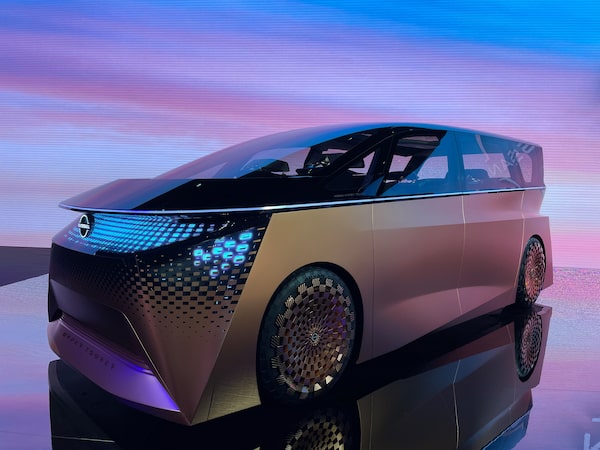The 2023 Japan Mobility Show is about a lot more than the newest concept and production cars. Automakers are using their knowledge and technology to reimagine how we can get around in better, more environmentally friendly ways, including for people with disabilities or other barriers in transportation. Here are five of our favourite:
1. Honda – UNI-one
This personal mobility device from Honda, called the UNI-one, is easy to use and hands-free. Sit down on the chair and steer by shifting your body weight. Lean forward to drive straight or turn by shifting your body in the direction you want to go. It can also raise or lower for more stability when getting on and a higher seating position so you’re closer to eye level with standing people. Designed for the elderly and people with disabilities, it offers more flexibility than a conventional wheelchair because your hands can move freely as if walking. Honda has been conducting demonstration testing on the UNI-one at Suzuka Circuit Park in Taiwan since October 2022.

The Honda UNI-one being tested during the 2023 Japan Mobility Show in Tokyo. The UNI-one is a personal mobility device.Petrina Gentile/The Globe and Mail
2. Suzuki MOQBA
Suzuki showcased several next-generation mobility options with wheels and four legs for people who face barriers in transportation, such as steps or steep inclines. This white four-legged device is called Modular Quad Based Architecture, or MOQBA for short. It can climb stairs, move objects like trash bins and transport patients on stretchers. The dog-like device is a combination of a motorcycle and a transport vehicle – people can ride on it or it can be used for moving objects or people from one place to another. The “stretcher mode” can be used to transport patients to hospitals in emergencies or medical situations. So far, Suzuki’s four-legged friend remains a concept, but it may turn it into real motorized device in the years to come.

Suzuki's line of next-generation mobility options, including the Modular Quad Based Architecture, or MOQBA for short, in the middle. It has four legs and can climb stairs.Petrina Gentile/The Globe and Mail
3. Yamaha Tricera trike
This three-wheeled open-air motorcycle comes courtesy of Yamaha Motor. It’s called Tricera and it looks like its straight out of a video game. It’s low to the ground, all-electric and has two wheels in the front and a single wheel at the rear. There’s no roof because it’s designed to give riders the feeling and freedom of an open-top convertible, but in a smaller, more efficient and practical size. While there are similar trikes on the road, like the Polaris Slingshot or Montreal’s Campagna T-Rex RR, there are no plans for the Tricera to go into production, yet.

The Yamaha Tricera trike is low to the ground, all-electric and has two wheels in the front and a single wheel at the rear.Petrina Gentile/The Globe and Mail
4. Toyota – Land Hopper
Here’s another three-wheeled electric vehicle, but it’s significantly smaller than the Tricera. This Toyota Land Hopper is a small bike with two wheels at the front and one at the rear. It’s more in line with a moped than a motorcycle. It has a smart, flexible, foldable design so it can easily fit into the trunk of your vehicle. The idea is to transport it in your vehicle and when you arrive at a destination, hop on and go for a spin to explore the local sights. It’s compact body size and low seat height make reaching the ground and getting on and off easy. The mechanically linked front wheels also move up and down; Toyota claims that creates a more exciting ride unlike a conventional car or bicycle.

The Toyota Land Hopper has a smart, flexible, foldable design so it can easily fit into the trunk of your vehicle.Petrina Gentile/The Globe and Mail
5. Nissan Hyper Tourer concept
Nissan takes the family road trip to new levels of luxury, comfort and mobility with this futuristic-looking Hyper Tourer concept. It’s an all-electric minivan with all the comforts of an upscale living room combined with advanced technologies, including autonomous driving capabilities. The front seats can swivel 360 degrees, allowing front- and rear-seat passengers to have face-to-face conversations. Rear-seat passengers can use a wearable display to view and operate the navigation and audio on the front centre display. The V2X, or vehicle-to-everything, functionality and high-capacity battery allows electricity to be supplied to homes, stores and offices when needed. And an innovative AI system can monitor biometric signs, such as brain waves, heart rate, breathing and perspiration and automatically select music and adjust the lighting to fit your mood.

The Nissan Hyper Tourer is an all-electric minivan with all the comforts of an upscale living room combined with advanced technologies like autonomous driving.Petrina Gentile/The Globe and Mail
 Petrina Gentile
Petrina Gentile